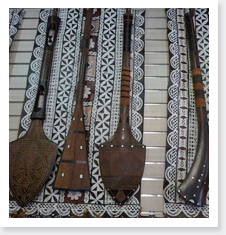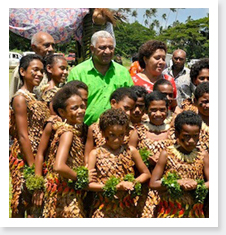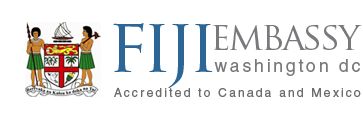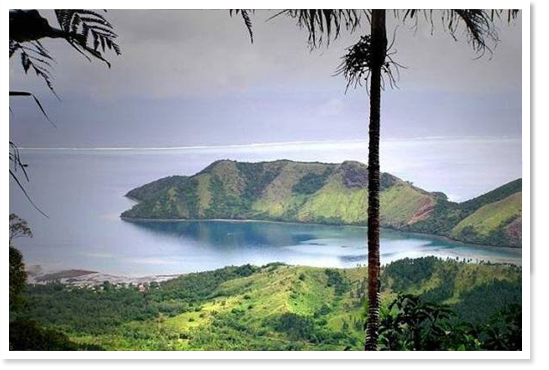|
FIJIAN CULTURE & TRADITION
 CULTURE CULTURE
Fiji was first settled about three and a half thousand years ago. The original inhabitants are now called “Lapita people” after a distinctive type of fine pottery they produced, remnants of which have been found in practically all the islands of the Pacific, east of New Guinea, though not in eastern Polynesia. Linguistic evidence suggests that they came from northern or central Vanuatu, or possibly the eastern Solomons.
Before long they had moved further on, colonizing Rotuma to the north, and Tonga and Samoa to the east. From there, vast distances were crossed to complete the settlement of the Pacific to Hawaii in the north, Rapanui (Easter Island) in the east and Aotearoa (New Zealand) in the South.
Unlike the islands of Polynesia which showed a continuous steadily evolving culture from initial occupation, Fiji appears to have undergone at least two periods of rapid culture change in prehistorically times.This may have been due to the arrival of fresh waves of immigrants, presumably from the west. Pre-historians have noted that a massive 12th century volcanic eruption in southern Vanuatu coincides with the disappearance there of a certain pottery style, and its sudden emergence in Fiji.
It is hardly surprising then, that the Fijian culture is an intricate network and that generalizations are fraught with danger. Although the legendary king of Bau, Naulivou, and his successors had control over a large area of eastern Fiji, at no time before colonialization was Fiji a political unity. Nevertheless, Fiji does exhibit certain traits that set it apart from its neighbors, and it is this that defines a distinctive Fijian culture.
 TRADITION TRADITION
FIJIAN ADMINISTRATION
Fiji is divided into 14 provinces, which are themselves composed of smaller administrative units, the basic one of which is the village (koro). At the head of a village is the turaga-ni-koro, elected or appointed by the villagers. Several koro forms a district (tikina) and several tikina make up a province or yasana. Each province is governed by a council with an executive head (Roko Tui) whose appointment has to be approved by the Fijian Affairs Board, which must also approve all rates and by-laws applied, by the provincial council. The Fijian Affairs Board is regarded as the guardian of the Fijian administrative system and many other aspects of Fijian custom.
MEKE (DANCE)
Visitors are often welcomed at resorts and hotels with a ‘meke’, a dance performance that enacts local stories and legends. While performances for tourists may seem staged, the meke is an ongoing tradition. The arrangement of the group and every subtle movement has significance. Important guests and onlookers are honoured with the best seating positions.
YAQONA DRINKING
Yaqona, otherwise known as kava, is an infusion prepared from the root of Piper methysticum, a type of pepper plant. It is extremely important in Fijian culture – in the time of the 'old religion' it was used ceremonially by chiefs and priests only. Today, yaqona is part of daily life, not only in villages but across the different races and in urban areas. 'Having grog’ is used for welcoming and bonding with visitors, for storytelling sessions or merely for passing time.
There are certain protocols to be followed at a kava ceremony and in some remote villages, it is still a semi religious experience. Sit cross-legged, facing the chief and the tanoa, or large wooden bowl. Women usually sit behind the men and won't get offered the first drink unless they are the guest of honour. Never walk across the circle of participants, turn your back to the tanoa or step over the cord that leads from the tanoa to a white cowry (it represents a link with the spirits).
The drink is prepared in the tanoa. The dried and powdered root, wrapped in a piece of cloth, is mixed with water and the resulting concoction looks (and tastes) like muddy water. You will then be offered a drink from a bilo (half a coconut shell). Clap once, accept the bilo and say 'bula' (meaning 'cheers', or literally, 'life'), before drinking it all in one go. Clap three times in gratification and try not to grimace. The drink will be shared until the tanoa is empty. You are not obligated to drink every bilo offered to you, but it is polite to drink at least the first.
BARK CLOTH AND TRADITIONAL TEXTILES
Masi, also known as tapa, is bark cloth with black and rust-colored printed designs. Masi played an important role in Fijian culture and its motifs had symbolic meaning and to a certain extent still do. It is used for special occasions – in 1996 the Tui Cakau wore masi ceremonial attire at his installation as paramount chief of the Cakaudrove region. Fijian masi is now mostly made for tourists and is used for postcards, wall hangings and other decorative items. Textile designers are now incorporating traditional masi motifs in their fabrics.
MAT AND BASKET WEAVING
Most Fijian homes use woven pandanus-leaf mats for floor coverings, dining mats and as finer sleeping mats. They are much in demand as wedding presents and for baptisms, funerals and presentations to chiefs. Most village girls learn the craft, traditionally it was the hereditary role of the women of certain tribes. The pandanus leaves are cut and laid outdoors to cure, then stripped of the spiny edges and boiled and dried. The traditional method for blackening the leaves for contrasting patterns is to bury them in mud for days and then boil them with special leaves. The dried pandanus leaves, made flexible by scraping with shells, are split into strips of about 1 to 2cm.
|



 FACTS ABOUT FIJI
FACTS ABOUT FIJI

